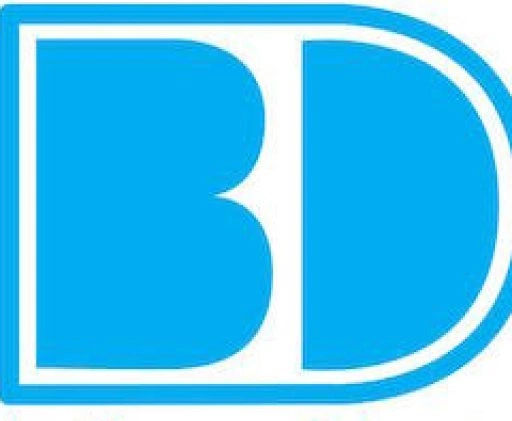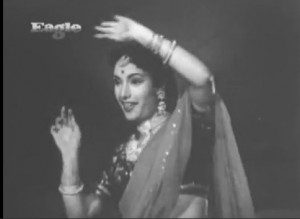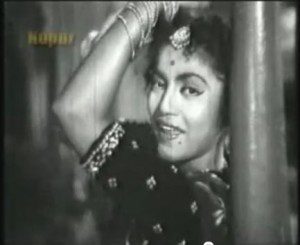She is the forgotten legend, even though she was considered one of the top singers amongst
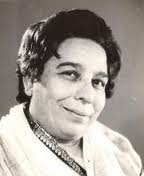
a constellation of stars such as Zohrabai Ambalewali, Amirbai Karnataki, Rajkumari, Juthika Roy, Noorjehan and Suraiya – and close behind, the phenomenon that was to become Lata Mangeshkar was making a grasp for the crown. Yet, she is hardly ever mentioned in the same breath as Lata Mangeshkar, Asha Bhonsle or Geeta Dutt. Even Noor Jehan and Suraiya were more popular.
Shamshad Begum, fondly called aapa ji (elder sister) by her contemporaries in the industry, came to India in 1944, encouraged by Lahore-based music director Ghulam Haider who had already used her to great effect in Khazanchi (1941) and Khandaan (1942). Apart from Ghulam Haider, C Ramchandra and Naushad worked with her the most. In fact, much before the juggernaut that was Lata Mangeshkar swept everyone else out of the way, Shamshad Begum was the preferred choice of voice for Nargis – Deedar, Mela, Aag, all had Nargis lip syncing to the Begum’s full-throated voice. That the rapid rise of Lata Mangeshkar dimmed her own prospects is something that Shamshad Begum has no qualms in admitting – yet, there is no rancour.
She has sung songs for most music directors, often when they were newcomers, and at less than her usual rate because they couldn’t afford her. Only to have them overlook her when they became famous in their own right. Even though some of them (C Ramchandra, OP Nayyar) admitted later on that they had been unfair to her. Too little, too late, perhaps, but Nayyar had the grace to mention in an interview on national television that Shamshad Begum had a great part to play in his success.
She gave very few interviews, never allowed herself to be photographed (she was conscious of her looks – or so it is said). Perhaps that is also the reason many people did not know her, though they had heard her and heard of her. Until the 1970s, no one had had a chance to see her photographs; in fact, she was often mistaken for the other Shamshad Begum (Saira Banu‘s grandmother) and in a tragic-comedy of errors, got to read her own obituary when the latter passed away!
In one of her rare interviews, she mentions how she had run into KL Saigal during the recording of the music of Shah Jehan. He didn’t know who she was, though she had been singing for more than a few years by that time. However, he had heard her sing, and was effusive with his compliments when he learnt who she was; much to her regret, she didn’t get a chance to sing with Saigal.
However, she worked with most of her other male contemporaries, chalking up hit duets with every one of them; she has also sung in tandem with mostly every female contemporary from Amirbai Karnataki and Zohre bai Ambalewali, to Geeta Dutt and the Mangeshkar sisters. In fact, apart from the Mangeshkar family, she holds the record of singing the maximum tandems with both Lata and Asha.
I must confess that she was not one of my favourite singers growing up. My father had a yen for the voices of Noor Jehan, Suraiya and Shamshad Begum, even though Lata was his lodestar – that was the only time I can remember that my tastes diverged from his. However, as I grew older, and listened to her songs, I began to understand what he liked about her voice.
Her voice had clarity of tone (OP Nayyar once referred to it as ‘clear as a temple bell’*), it had kashish, it had soul, it had feeling. Here, in chronological order of films, is a compilation of her solo songs for 15 different composers, not by any means the complete list of the music directors she worked with…
1. Dil thandi hawa mein
 Shama (1946)
Shama (1946)
Music: Ghulam Haider
Lyrics: Kaifi Azmi
Having sung for Master Ghulam Haider in Khazanchi, Khandaan, and Zamindar, Shamshad Begum only moved from Lahore to Bombay because Mehboob Khan personally requested her to – it was for Taqdeer (1942). When Ghulam Haider also moved to Bombay, he signed Shamshad Begum for all the movies that he was working on. He can, possibly, claim to be her mentor, having groomed her from her initial days in the industry. Dil thandi hawa mein has two versions – this one, sung by Shamshad and another, sung by Suraiya, who also starred in the movie. The other Ghulam Haider-Shamshad song that ran a close second was Naina bhar aaye teer a beautiful number from Humayun (1945) picturised on Veena.
2. Kahe koyal shor machaye re
 Aag (1948)
Aag (1948)
Music: Ram Ganguly
Lyrics: Behzaad Lucknawi
Music director Ganguly was the music director of Prithvi Theatres; Shamshad Begum talks of meeting him and the young Raj Kapoor, who had come to her to ask her to sing in the young man’s directorial debut. She recalls him introducing himself as ‘Prithviraj Kapoor‘s son’ – and though she was swamped with work at the time, she took on Aag because of her respect for Prithviraj Kapoor. It is unfortunate that Raj Kapoor had a falling out with Ram Ganguly during the making of Aag and formed his own musical team with Shankar and Jaikishen. Unfortunate, because S-J preferred Lata Mangeshkar (Barsaat was the film that set them all on the path to success) to Shamshad. I do not recall a single song that Shamshad sang for RK films after this – other than the one solo she sang in Awara. However, Raj Kapoor always acknowledged the debt he owed her. Also unfortunate, because, Aag had some unusual melodies. And while S-J went on to make their fame and fortune, Ram Ganguly languished, not in the wilderness, perhaps, but definitely in relative anonymity.
3. Mohan ki muraliya baaje
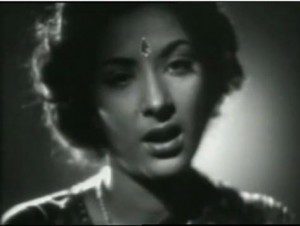 Mela (1948)
Mela (1948)
Music: Naushad
Lyrics: Shakeel Badayuni
Many of Shamshad’s biggest hits came under music director Naushad’s baton. Her first song for Naushad was for Jab usne gesu bikhraye from Shah Jehan (1946), and she managed to hold her own among a plethora of KL Saigal numbers. It was the beginning of a long and successful relationship – Naushad has often said that after Lata, Shamshad was his favourite female voice. It is interesting to note that she was already an established singer when Naushad entered films. My other choices for a Naushad-Shamshad collaboration were the lovely Chaman mein rehke veerana from Deedar (1951) or Aag lagi tan man mein from Aan (1952).
4. Na tum aaye na neend aayi
Rimjhim (1949)
Music: Khemchand Prakash
Lyrics: Bharat Vyas
It is unfortunate that there aren’t any videos available for this song. Or for any other from the film, for that matter. However, this is perhaps the best way of judging Shamshad’s voice – without the added distraction of ‘seeing’ someone lip sync on screen. The clarity of enunciation, the depth of feeling, the effortless ease with which she ’emotes’ – sublime.
5. Balam tujhe mera salaam
 Patanga (1949)
Patanga (1949)
Music: C Ramchandra
Lyrics: Rajinder Krishen
C Ramchandra had already worked with Shamshad Begum in Safar (1946) Shehnai (1947 – famous for the classic Rock n’ Roll based duet Meri jaan, meri jaan Sunday ke Sunday) and a few other movies before this 1949 classic. In fact, the most famous song from Patanga is the Chitalkar-Shamshad Begum duet Mere piya gaye Rangoon that was picturised on Nigar Sultana and Gopi. This is picturised on Nigar, as she tries to help sell gala khol davaayi. Quite apt, don’t you think, considering Shamshad’s bell-like tones? Unfortunately, after a long, and fruitful association with Shamshad (they worked together in more than twenty films), and acknowledging her contribution to his success, C Ramachandra moved on to Lata Mangeshkar and his professional relationship with Shamshad was never the same again.
6. Saiyyan dil mein aana re
 Bahaar (1951)
Bahaar (1951)
Music: SD Burman
Lyrics: Rajinder Krishan
Shamshad had sung for Burmanda earlier (in Shabnam 1949), and in fact, the playful Ek baar tu ban ja mera o pardesi ran Saiyyan dil mein aana re a close second when I was choosing a Shamshad-Burmanda collaboration. In fact, the only reason this one won was because it had Vyjayanthimala in her debut in Hindi films – a remake of her debut film Vaazhkai. She was 16. This song has Vyjayanthimala in the throes of first love, bursting into song. Shamshad is at her playful best, as Vyjayanthimala pirouettes, and sings prettily to the man who has stolen her heart. And by the way, the photo is that of Karan Dewan, the film’s hero.
7. Ichak bichak churr
 Baawre Nain(1950)
Baawre Nain(1950)
Music: Roshan
Lyrics: Kidar Sharma
This was Roshan’s chance to redeem himself after the devastating failure of his debut film, Neki aur Badi (1950). Kidar Sharma, who was also Raj Kapoor’s mentor, gave Roshan his second chance, and Roshan never looked back – the amazing score that he mounted for the tragedy that played out on screen propelled him onto the top rung of music directors in the Hindi film industry. Shamshad had only one solo in Baawre Nain. If Asha Bhonsle came to be known as Helen‘s voice, then Shamshad Begum was Cuckoo’s. However, in this song, she is playback for Geeta Bali as Cuckoo dances.
8. Thandi hawa ke jhonke
Bhai Bahen (1950)
Music: Shyam Sunder
Lyrics: Ishwar Chandra Kapoor
Shyam Sunder has to his credit his ‘discovery’ of Mohammed Rafi. The composer was in the audience at a KL Saigal performance, when the power went off and Saigal refused to perform. Mohammed Rafi’s brother requested the organisers to let his brother sing – this was Rafi’s first public performance. He was 13. Shyam Sunder was so impressed that he invited the young lad to come to Bombay. Rafi’s first recorded song was for Shyam Sunder – for a Punjabi film called Gul Baloch in 1944. Apart from this, I have an abysmal lack of knowledge about this composer. From the research I did for this post, he seems to have composed for about 15 films – from those, I have heard of two – Char Din and Alif Laila.
I can’t even find videos for the songs from any of these films, so I’m left floundering. However, having listened to the audios of many of these (the ones that are available), most are at least familiar. Which leads me to wonder how much of our past history, both visual and aural, has been destroyed because there is no attempt to keep a record for future generations.
9. Husnwalon ki galiyon mein aana nahin
 Sheesh Mahal (1950)
Sheesh Mahal (1950)
Music: Vasant Desai
Lyrics: Shumz Lucknawi
Sohrab Modi was well-known for social activism through his movies, and Sheesh Mahal is no exception. From historicals, he moved easily across to social themes, as the winds of change blew over the country. It’s a piquant situation, as Ranjana (Naseem Banu), the daughter of the aristocratic owner of the titular Sheesh Mahal, ends up working as the maid-companion of Roopa (Nigar Sultana),the daughter of the new owner of the mansion. And now, she has the unpleasant task of persuading her new mistress to not fall in love with Sunder (Pran) – without letting it be known that Sunder used to be her (Ranjana’s) fiancé until he threw her over for Roopa once her father lost his property.
10. Jin aankhon mein neend haraam hui
Music: Bulo C Rani
Lyrics: Buta Ram Sharma
A landmark film in the annals of Hindi Cinema, Kidar Sharma’s Jogan explored a reasonably bold theme for those days – the attraction of a man Vijay (Dilip Kumar) for a woman Surabhi (Nargis), whose very vocation meant that she couldn’t reciprocate. This song, however, is picturised on Poornima (Anjani), with Dilip Kumar and Rajendra Kumar (Raj) as the riveted audience. This was Rajendra Kumar’s debut. He played Dilip Kumar’s friend. I find this song interesting for the variations in its tempo, which almost doubles in the middle, and then, as quickly reduces to slightly less than half of where it originally began. And Shamshad Begum moves from the half-beat to the double and back without missing a note. Her voice control is fantastic!
11. Ek do teen aaja mausam
 Awaara (1951)
Awaara (1951)
Music: Shankar-Jaikishen
Lyrics: Shailendra
Shamshad Begum first met Shankar when he came along with Ram Ganguly and Raj Kapoor to her house to rehearse the songs for Aag. He played the tabla then. When Raj Kapoor fell out with Ganguly, he picked Shankar and his friend Jaikishen as the music directors for his next film, Barsaat.
Raj Kapoor had never worked with Shamshad Begum after Aag. Shankar and Jaikishen had both started their careers with Lata Mangeshkar, and preferred her to any other female singer. In fact, Raj Kapoor (apparently) acknowledged that Jaikishen did not like Shamshad, which is why S-J never used her if they could help it. She sang a sum total of three songs for S-J. Despite the supposed dislike, they were forced to ask her to sing in Awaara – she was well known as Cuckoo’s voice, and the song was to be picturised on the legendary dancer. It is interesting that in a score that is even today, regarded as a classic, it was Ek do teen that broke all records when the music was released.
12. Le chal wahan piya jahan
Music: Sajjad Hussein
Lyrics: Rajinder Krishen
A collaboration between two legends – a singer with a unique voice, and a temperamental composer who had the reputation of walking out of films half way if he didn’t like something. Perhaps it was unfortunate that while he completed Sangdil, he had a falling out with its hero, Dilip Kumar, and thereafter never worked with Yousef saab again. Sajjad’s compositions for Sangdil included Talat‘s silken Yeh hawa yeh raat yeh chaandni and the beautiful duet Dil mein samaa gaye sajan. Le chal wahan piya jahan was one of the few songs that Shamshad recorded for Sajjad – and it is unfortunate indeed, that it was not used in the film.
13. Kabhi aar kabhi paar
Music: OP Nayyar
Lyrics: Majrooh Sultanpuri
This was the first song that Shamshad Begum sang for OP Nayyar. (IMDB puts Mangu as an earlier OP Nayyar film and also lists Shamshad Begum as singer. She, however, said in an interview that OP Nayyar was a non-entity when he came to her for Aar Paar.) It is true that it was Aar Paar that was OP Nayyar’s first big hit, and the title song (Kabhi Aar Kabhi Paar) was one of the year’s biggest successes. Interesting bit of trivia: This was Kumkum‘s first appearance on screen and her first song. She went on to become a successful supporting actress, and a regular in Guru Dutt‘s movies.
14. Na jaan re na jaan re
Music: Salil Choudhary
Lyrics: Prem Dhawan
Salil Choudhary was another composer who didn’t use Shamshad very often. From what I can gather, she sang a sum-total of three songs for the maestro. However, when he did use her, she delivered, and how! This is a rare gem, both for the rarity of the collaboration, and for the music and delivery.
Interestingly, he also used Mohammed Rafi (though their ways of working differed) forBiraj Bahu, along with Hemant Kumar, Lata Mangeshkar,Shyamal Mitra and Nirmalendu Choudhary.
15. Tere bangle ki
Music: Avinash Vyas
Lyrics: Bharat Vyas
I do not know much about Avinash Vyas as a music director. However, this song is really beautiful. A lilting dance song, and sung in inimitable Shamshad style. I’d like to know who the dancer is, but then, the cast is not very well-known – I only recognised Lalita Pawar and David. What I did gather from the film was it seemed to be a family venture – the director is a VS Vyas, the music director is Avinash Vyas, the lyricist is Bharat Vyas. Avinash Vyas seems to have composed for over twenty films, and with the rather decent score that this film had (Mohammed Rafi, Shamshad Begum, and Geeta Dutt front lined the playback), I’m surprised he is not very well-known.
I promise you this is just the tip of the iceberg. It is hard to do justice to her oeuvre as an artiste in only one post and I had a hard time cutting songs from the list, even though I’m sure I have missed out on many other composers with whom she worked. The list grew so large, and the weaning process so onerous (I was spending more time listening than writing) that I decided to:
a) Stick to one song per composer
b) Compile her duets with her many contemporaries in a supplementary post. So watch out for part 2.
© Anuradha Warrier
Main image courtesy: Indianexpress.com
Written By: Anuradha Warrier, is a writer, editor, film, and music buff. She writes for pleasure, edits for a living, and indulges in watching films, listening to music, and writing about both on her blog Conversations Over Chai as and when time permits.
DISCLAIMER: The views expressed are solely of the author and Bollywoodirect.com do not necessarily subscribe to it. Bollywoodirect.com shall not be responsible for any damage caused to any person/organisation directly or indirectly.
